12-14 Several binary star systems contain black holes
Black holes are more than fine points of relativity theory: They are real. Their presence has been observed by their effects on the orbits of other stars and on gas and dust near them, and more of them are being located all the time. To find evidence for black holes, we look first to binary star systems.
The technique for detecting black holes formed from collapsing stars is based on the interaction between the black hole and its binary companion. When one star in a close binary becomes a black hole, its gravitational attraction pulls off some of its companion’s atmosphere. However, such black holes have diameters of only a few kilometers, so there is not enough room for all that gas to fall straight in. Rather, the infalling gas swirls into the black hole like water going down a bathtub drain (Figure 12-41). The gas that is waiting to fall in forms an accretion disk, that is, a disk of gas and dust spiraling in toward the black hole. Magnetic fields in the disk help pull the debris inward. Calculations reveal that this gas is compressed and thereby heated so much from the collisions of its particles that it gives off X-rays (Figure 12-42). Thus, if a visible star has a sufficiently tiny, sufficiently massive X-ray–emitting companion, we have located a black hole.
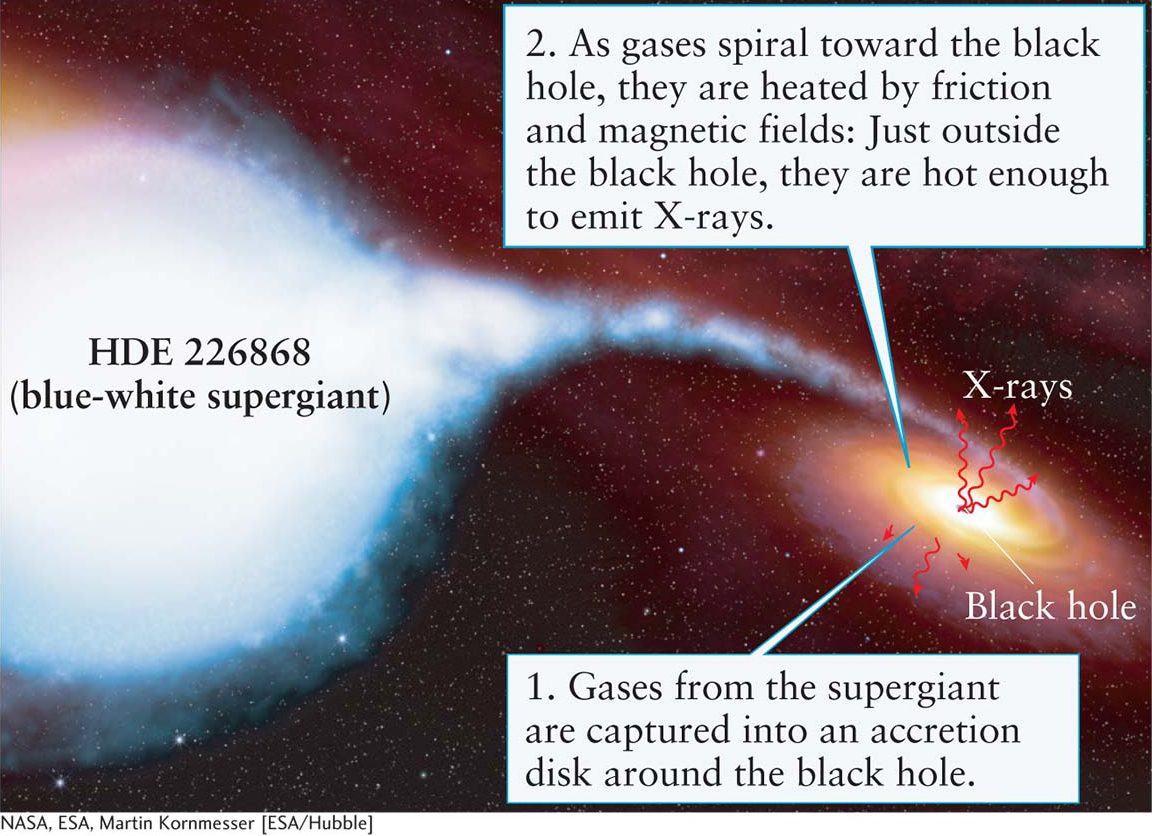
Figure 12-42: X-Rays Generated by Accretion of Matter Near a Black Hole Stellar-remnant black holes, such as Cygnus X-1, LMC X-3, V404 Cygni, and probably A0620-00, are detected in close binary star systems. This drawing (of the Cygnus X-1 system) shows how gas from the 30 M⊙ companion star, HDE 226868, transfers to the black hole, which has at least 11 M⊙. This process creates an accretion disk. As the gas spirals inward, friction and compression heat it so much that the gas emits X-rays, which astronomers can detect.
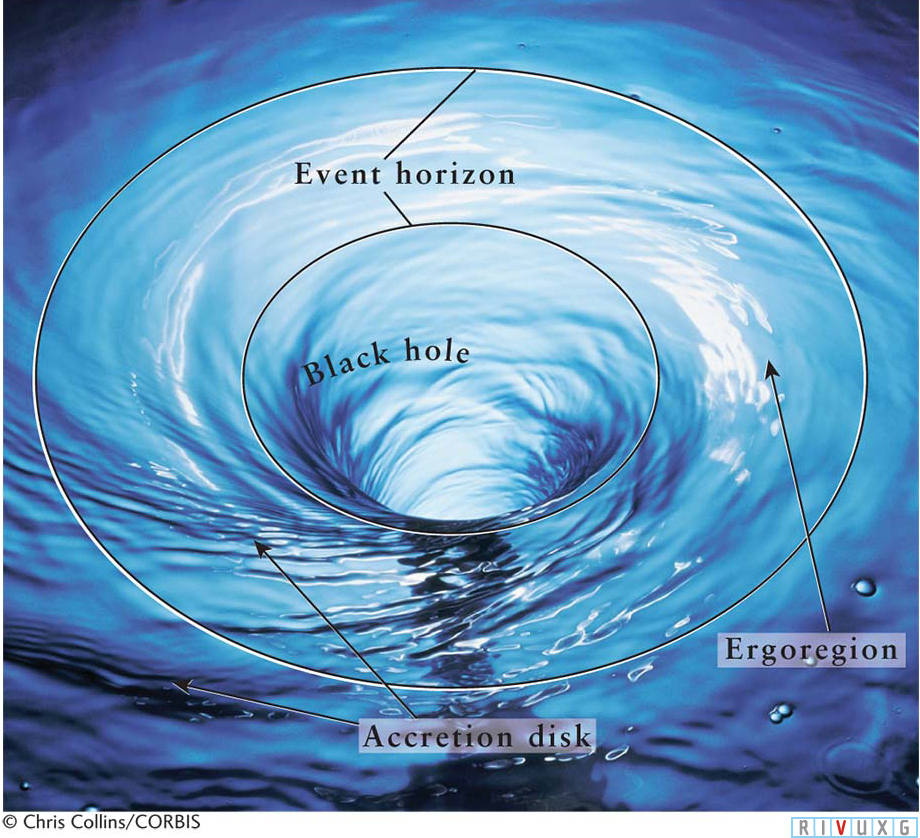
Figure 12-41:  Formation of an Accretion Disk Just as the water in this photograph swirls around waiting to get down the drain, the matter pulled toward a black hole spirals inward. Angular momentum of the infalling gas and dust causes them to form an accretion disk around the hole.
Formation of an Accretion Disk Just as the water in this photograph swirls around waiting to get down the drain, the matter pulled toward a black hole spirals inward. Angular momentum of the infalling gas and dust causes them to form an accretion disk around the hole.
To date, in the Milky Way Galaxy alone, at least 10 stellar-remnant black holes in binary star systems have been identified (Table 12-2). There is also growing evidence that black holes can collide with each other or with different types of objects, such as neutron stars.
TABLE 12-2 STELLAR BLACK HOLES IN THE MILKY WAY
Data from R. Blandford and N. Gehrels, “Revisiting the Black Hole,” Physics Today, June 1999.
12-15 Other black holes range in mass up to billions of solar masses
Focus Question 12-19
Why is the gas in an accretion disk heated?
Based on the equations of general relativity, the fate of massive neutron stars led as early as 1939 to the idea of black holes. Since then, calculations have supported at least three other types of black holes:
Early in the life of the universe, black holes could have formed from the condensation of vast amounts of gas and also from the collisions of stars during the process of galaxy formation, thereby creating supermassive black holes, each with millions or billions of solar masses.
We saw in Section 11-2 that stars form in clusters. If a cluster forms with enough stars concentrated in a sufficiently small volume of space, collisions between stars in the center of the cluster may lead to the formation of a black hole with between a few hundred and a few thousand solar masses. Such objects are called intermediate-mass black holes.
Black holes could have formed during the explosive beginning of the universe as tiny amounts of matter were compressed sufficiently to form primordial black holes. These bodies would have masses ranging from a few grams to the mass of a planet.
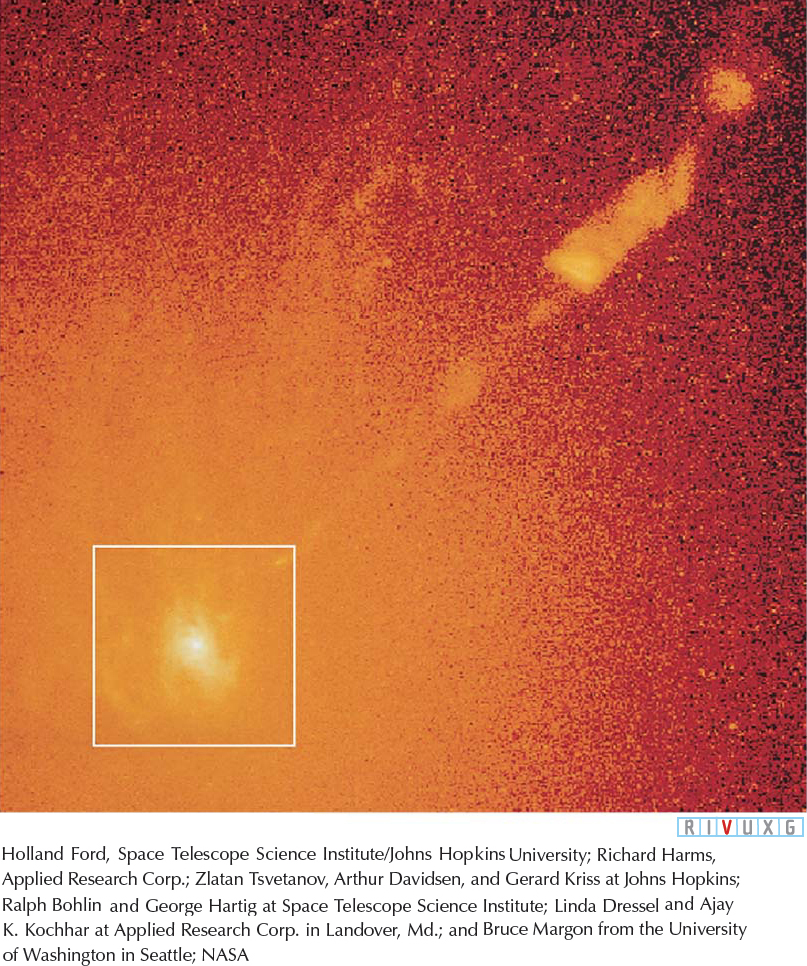
Figure 12-43:  Supermassive Black Hole The bright region in the center of galaxy M87 has stars and gas held in tight orbits by a black hole. M87’s bright nucleus (center of the region in the white box) is only about the size of the solar system but it pulls on the nearby stars with so much force that astronomers calculate that it is a 3 × 109 M⊙ black hole. One of the bright jets of gas shooting out perpendicular to the black hole’s accretion disk (discussed in Section 12–14) is visible at the upper right on this image.
Supermassive Black Hole The bright region in the center of galaxy M87 has stars and gas held in tight orbits by a black hole. M87’s bright nucleus (center of the region in the white box) is only about the size of the solar system but it pulls on the nearby stars with so much force that astronomers calculate that it is a 3 × 109 M⊙ black hole. One of the bright jets of gas shooting out perpendicular to the black hole’s accretion disk (discussed in Section 12–14) is visible at the upper right on this image.
Supermassive black holesIn May 1994, the Hubble Space Telescope obtained compelling evidence for a black hole at the center of the galaxy M87. In the nucleus of M87 is a tiny, bright source of light. Spectra showed that nearby gas and stars are orbiting it extremely rapidly. They can be held in place only if the bright object contains some 3 billion solar masses (Figure 12-43). Given that the source’s size is only slightly larger than the solar system, it can only be a black hole.
Since 1994, black holes in the centers of many galaxies have been identified by their X-ray emissions and gravitational effects on surrounding gas and stars. For example, a distinct, Frisbee-shaped disk of gas and dust around the supermassive black hole in NGC 7052 was seen by the Hubble Space Telescope in 1998 (Figure 12-44). A black hole containing about 4 million solar masses has even been found at the center of our Milky Way, only 26,000 light-years from Earth. Indeed, evidence for central, supermassive black holes has been found in most of the several dozen nearest galaxies. To date, over 2.5 million supermassive black holes have been identified and astronomers are coming to the conclusion that they exist in the centers of most, if not all, large galaxies. We discuss the effects of these supermassive black holes (also called active galactic nuclei) on the galaxies in which they reside in the next chapter.
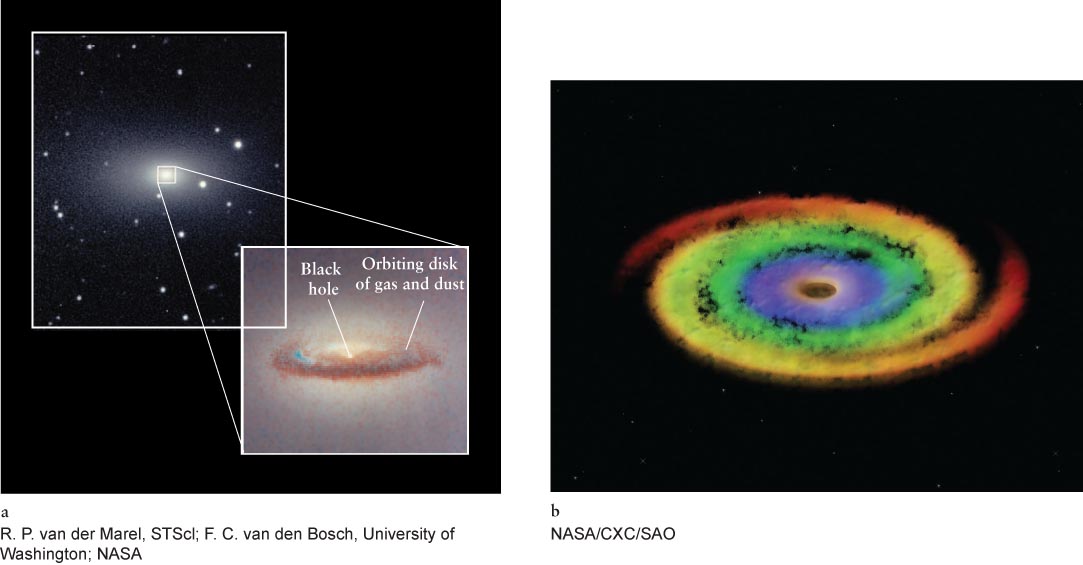
Figure 12-44: Disk of Gas and Dust Around a Supermassive Black Hole (a) Swirling around a 3 × 108 M⊙ black hole in the center of the galaxy NGC 7052, this disk of gas and dust is 3700 ly across. The gas is cascading into the black hole, which will consume it over the next few billion years. The black hole appears bright because of light emitted by the hot, accreting gas outside its event horizon. NGC 7052 is 191 million ly from Earth in the constellation Vulpecula. (b) This drawing shows how the gases spiraling inward in an accretion disk heat up as they approach the black hole. Color coding follows Wien’s law: red (coolest), followed by orange, yellow, green, blue, and violet (hottest).
Earlier in this book we studied how tidal effects of one body on another occur in several situations, including the Earth–Moon system and the heating of Io and Europa by Jupiter. In 2004, astronomers observed several supermassive black holes in other galaxies absorbing parts of passing stars. These black holes created such high tides on those stars that the stars were pulled apart. Some of each star’s mass was then drawn into the black hole. These discoveries were made because infalling gas from the stars was rapidly heated to millions of kelvins, causing the gas to emit a burst of X-rays that was observed by orbiting telescopes. Subsequent observations also reveal that supermassive black holes can consume vast quantities of interstellar gas, sometimes stripping enough gas from a galaxy to prevent it from forming new generations of stars.
As we will explore in more detail in Chapter 13, galaxies were created from condensing gas and stars in the early universe. Our technology is now providing us with observations of that epoch of the universe, and the formation process of supermassive black holes in the centers of galaxies is now being studied. These black holes apparently formed, in part, from the gas that was condensing to create galaxies and, in part, from the collisions of stars and black holes that came into existence shortly after the beginning of time. Observational evidence indicates that the formation of supermassive black holes is still ongoing. We will explore this further later in this chapter.
Focus Question 12-20
Where are supermassive black holes located?
Intermediate-mass black holesAt the end of the twentieth century, astronomers began discovering objects that appear to be black holes with between 102 and 105 M⊙. Again, these objects were identified as potential black holes by the intensity and spectra of the X-rays that they emit and by the orbits of stars around them. For example, near the center of the galaxy M82, astronomers found what appears to be a 500–1000 M⊙ black hole (Figure 12-45), while in the galaxy NGC 1313, astronomers have observed what appears to be two intermediate-mass black holes, each with 200–500 M⊙. Most intermediate-mass black holes are observed in globular clusters.

Figure 12-45: An Intermediate-Mass Black Hole M82 is an unusual galaxy in the constellation Ursa Major. The inset shows an image of the central region of M82 from the Chandra X-ray Observatory. The bright, compact X-ray source shown varies in its light output over a period of months. The properties of this source suggest that it is a black hole of roughly 500 M⊙.
In support of the belief that these objects are black holes, computer simulations of stars in the crowded regions, where such objects are found, show that black holes in this mass range can form as a result of collisions and close tidal interactions between stars. Do not fear—such a black hole will not develop near Earth. There have to be at least a million times more stars per volume than there are in our stellar neighborhood for such frequent stellar collisions or near misses to occur.
Primordial black holesEven more exotic black holes may have formed along with the universe itself. The British astrophysicist Stephen Hawking has proposed that the Big Bang explosion from which most astronomers believe the universe emerged may have been chaotic and powerful enough to have compressed tiny knots of matter into primordial black holes. Their masses may have ranged from a few grams to greater than the mass of Earth. Astronomers have not yet observed evidence of primordial black holes, although that does not mean they do not necessarily exist—just that we cannot yet detect them.
12-16 Black holes and neutron stars in binary systems often create jets of gas
We saw in Section 12-10 how rotating beams of radiation are emitted by neutron stars. Similarly, many neutron stars and black holes emit steady (nonrotating) pairs of gas jets shooting out in opposite directions.
Consider a black hole (neutron stars behave analogously) in a binary system. If the companion star is still fusing material, its outer layers can be pulled off, as discussed in Section 11-15. The infall of this matter toward the compact companion (which has a Schwarzschild radius of only a few kilometers or miles) is too rapid for all of the mass to immediately enter the event horizon. The resulting accretion disk around the black hole is the key to explaining the presence of the jets.
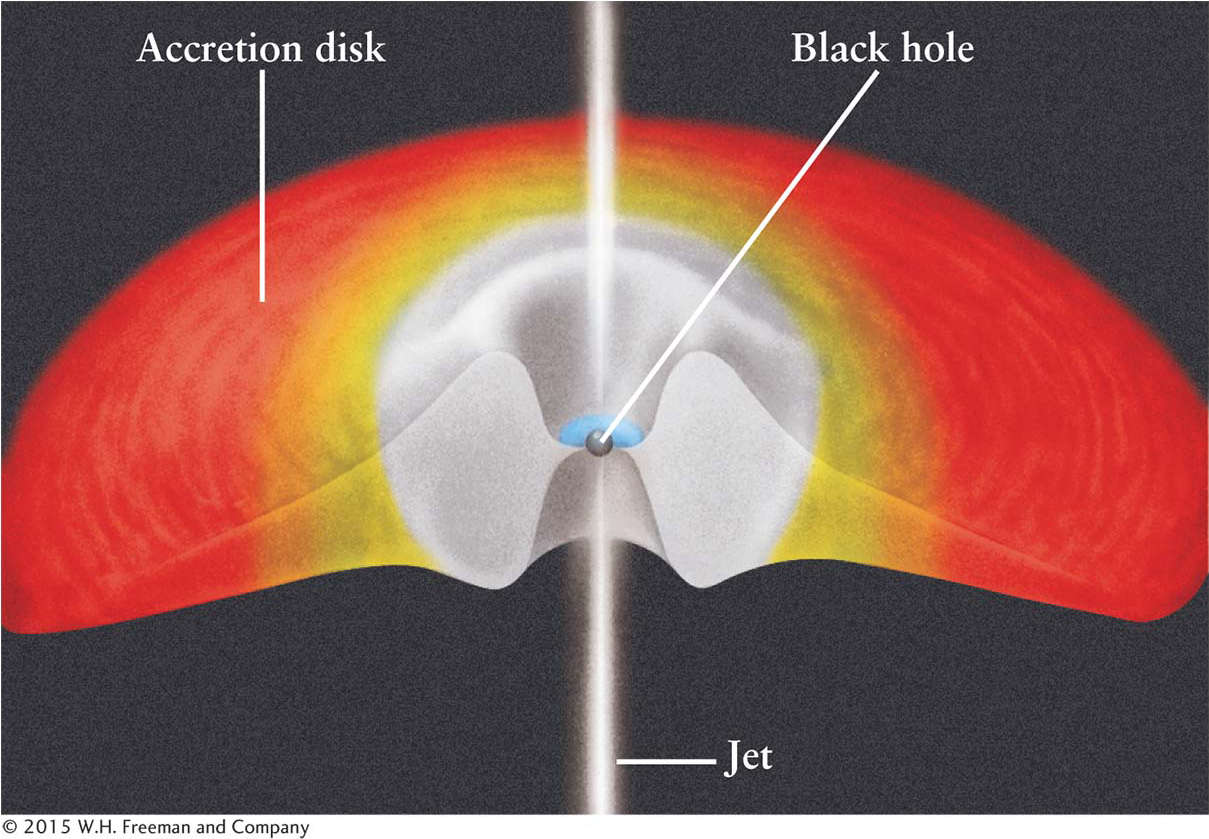
Figure 12-46: Jets Created by a Black Hole in a Binary System Some of the matter spiraling inward in the accretion disk around a black hole is superheated and redirected outward to produce two powerful jets of particles that travel at close to the speed of light. The companion star is off to one side of this drawing.
As the disk mass spirals down toward the event horizon, this gas is compressed into a smaller volume. Such compression heats the gas, which, in turn, causes its pressure to increase. As a result of the increased pressure, the gas expands, forming a doughnut-shaped region around the black hole (Figure 12-46). As the gas starts the final plunge toward the black hole, its temperature skyrockets to tens or even hundreds of millions of kelvins. At such temperatures, the pressure is so great that much of the infalling gas expands and, finding little resistance perpendicular to the plane of the accretion disk, it squirts out as two jets (Figure 12-46). These jets are prevented from spreading out by a magnetic field created as the hot gases orbit in the accretion disk and by pressure from surrounding gas. Astronomers have measured the speed of this gas to be as fast as 32 × 106 km/hr (20 × 106 mi/hr) or 3% of the speed of light.
Whereas neutron stars and stellar-mass black holes create jets as a result of being in binary star systems, supermassive black holes have so much gravitational attraction that they pull huge quantities of nearby interstellar gas and dust into orbit around themselves without needing a binary companion. Figure 12-44a shows such a disk, and Figure 12-43 shows one of the jets emitted by the supermassive black hole in M87. We will explore more about jets created by black holes in Chapter 13.


 Formation of an Accretion Disk Just as the water in this photograph swirls around waiting to get down the drain, the matter pulled toward a black hole spirals inward. Angular momentum of the infalling gas and dust causes them to form an accretion disk around the hole.
Formation of an Accretion Disk Just as the water in this photograph swirls around waiting to get down the drain, the matter pulled toward a black hole spirals inward. Angular momentum of the infalling gas and dust causes them to form an accretion disk around the hole.

 Supermassive Black Hole The bright region in the center of galaxy M87 has stars and gas held in tight orbits by a black hole. M87’s bright nucleus (center of the region in the white box) is only about the size of the solar system but it pulls on the nearby stars with so much force that astronomers calculate that it is a 3 × 109 M⊙ black hole. One of the bright jets of gas shooting out perpendicular to the black hole’s accretion disk (discussed in Section 12–
Supermassive Black Hole The bright region in the center of galaxy M87 has stars and gas held in tight orbits by a black hole. M87’s bright nucleus (center of the region in the white box) is only about the size of the solar system but it pulls on the nearby stars with so much force that astronomers calculate that it is a 3 × 109 M⊙ black hole. One of the bright jets of gas shooting out perpendicular to the black hole’s accretion disk (discussed in Section 12–

